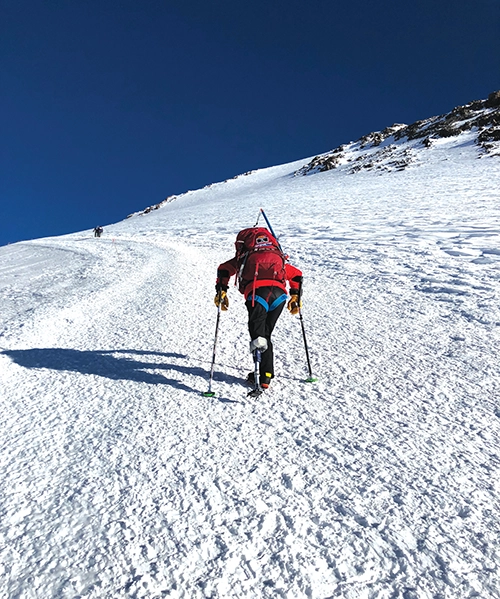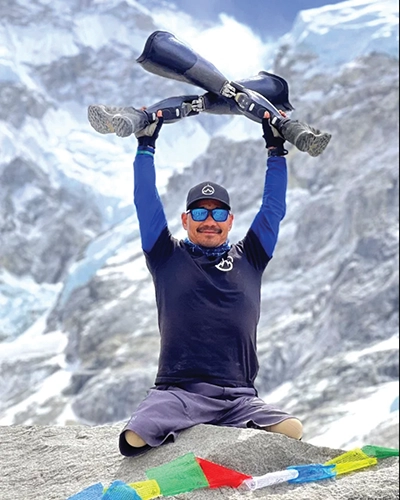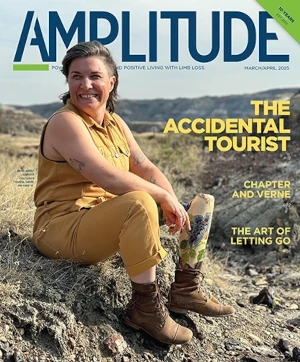The amputee climber has been chasing the Seven Summits since 2017. This month, the former Marine aims to complete her mission at last.
Back in 2017, the same year she launched her quest to reach the highest peak on all seven continents, Kirstie Ennis summed up the endeavor in a mordant Twitter post:


At that time, Ennis had already reached two of the so-called Seven Summits. She’s bagged another four in the five years since, leaving just one to conquer: Everest. She came achingly close to taking that trophy in 2019, getting within 600 vertical feet of the peak before her team’s oxygen tanks ran critically low. Their supply would have been sufficient to get them to the summit, but it would have run out before the group could descend safely out of the Death Zone.
“I would not be able to live with myself if anything happened to one of my team because I was too stubborn to make the right call,” she wrote afterward. At Ennis’ insistence, the group turned around and headed back to Camp 4.
A former Marine sergeant who served in Afghanistan, Ennis was trained to make life-or-death decisions. And she knows how it feels to lose comrades—she lost six in the same 2012 helicopter crash that nearly killed her and eventually led to the amputation of her left leg. Risking her partners’ welfare would undermine the whole rationale behind the Seven Summits challenge: to affirm life, to celebrate her own miraculous survival, and to honor the sacrifices of fellow soldiers who are no longer able to climb their own mountains.
“There’s healing power in doing things for other people,” she says. Every climb raises money for the Kirstie Ennis Foundation, which funds recreational and mental health programs for wounded warriors and other people with disabilities. Since embarking on the Seven Summits mission, she has won the Pat Tillman Award for Service and earned Marine of the Day recognition from US Veterans Magazine. She also holds nearly a dozen medals for meritorious service.
Placing others’ safety on Everest over her own ambition was totally consistent with how Ennis lives. “Tough call being so close to the top,” she said later, “but it wasn’t worth anyone’s injury or death. The mountain’s not gonna go anywhere. I can come back.”
The pandemic delayed her return, but the moment has arrived. This month Ennis will take another crack at the summit that Nepalis call Sagarmatha, “Goddess of the Sky.” If she’s successful, she’ll become the first American amputee to reach all Seven Summits and the second overall, behind Indian climber Arunima Sinha (who finished in 2019). The sequence of pain, planning, and persistence Ennis described on Twitter can finally end with a period. Or maybe an exclamation point.
Amplitude traded emails with Ennis a few weeks ago, before she and her team left for Nepal. To keep track of her Everest attempt in real time, log on at share.garmin.com/kirstieennis and type in the password “KEverest23.” If you want a glimpse of what it’s like up there, we recommend “Standing Tall,” the 42-minute documentary about Ennis’ 2019 summit attempt. Find it at watch.outsideonline.com.
Q&A With Kirstie Ennis
Why is it important for an amputee to reach the Seven Summits?
Representation matters. The outdoors isn’t just for one type of person. These extreme endeavors also advance medical device technology, develop new tools for others to explore, and show the world that we write our definitions in life—that a disability doesn’t prevent you from living.

over the world expand their horizons.
You’ve been chasing the Seven Summits since 2017. How has this experience changed you? What lessons have you learned along the way?
The experience of the Seven Summits has changed me in the way I commit and stay dedicated. I have always prided myself in keeping my word and showing up. This has been a true test over the years, of time, energy, money, physically, and even in prosthetics advancement. It’s been a reminder of what I am capable of—that it doesn’t matter what I look like or if how I do things looks differently than others, as long as I have the courage to go try. It’s also taught me the importance of shifting my perspective.
Are there any specific moments that have stuck with you?
Two moments come to mind. One is when I had to turn around on Denali in June 2018, and how bitter and angry I was since it wasn’t my fault (I later summited in June 2021). The other is when I made the decision to turn around on Everest in 2019. I wasn’t angry; I was heartbroken. But knew I was making the right call since my climbing partners ran out of oxygen, and I wouldn’t be able to live with myself. On the descent I was calm and at peace, unlike when I turned around on Denali.
What do you draw strength from when you’re in a tough moment?
I draw strength from people. When it gets tough day to day, or in the crux of a climb, I think of my parents and my sister. I think of the people watching—both those pulling for me and even the few who may want me to fail. Climbs aren’t about me anymore. I climb for others.
When you wrote on Twitter that you forget the pain in between climbs—do you really forget? Or is it more accurate to say you absorb the pain, grow stronger from it, achieve a truce with it? I’m asking because every amputee goes through a process of accommodating pain and building a relationship with it.
Yes, you really forget the pain. I always say you just have to be strong, stubborn, and stupid to be a good mountaineer. You disassociate with how much it hurts physically, mentally, and emotionally, and you look beyond it. If I remembered and reflected on how miserable it was, I wouldn’t keep going back for more. You learn to focus on the highs and fight through the lows in ways that I probably can’t put into words. But if I continuously shared the bad, I would talk myself out of climbing.
I think the pain you’re referring to is much different than what I’m referring to in the mountains. As an amputee, you do absorb the pain of a prosthetic, and it becomes routine.
What do you think about when you’re on the mountain? Are you concentrating on tactics 100 percent of the time? Do you ever have time to reflect on the bigger picture?
I think about what I am going to do when I get down. I am typically planning my next climb halfway through the climb I’m currently on. I’m probably only thinking about tactics 50 percent of the time. During the long slogs of climbs, I am often daydreaming or thinking about how I am going to describe what I am seeing, smelling, feeling when it comes time to journal. During the technical parts, I am fully present and thinking about what my next move will be and relying on staying calm when chaos presents itself.
What’s your greatest fear heading into this climb?
Frostbite on my residual limb. It’s always frostbite on every climb.
What prosthetic gear do you have to bring with you? What’s in the kit?
I bring a backup socket, knee, and homemade crampon foot that is identical to what I will already be wearing on the mountain. I have at least a dozen Allen wrenches, since those go missing pretty frequently. Duct tape. Loctite. Three extra valves. An extra liner. Hip belt. Rolls of Tegaderm. Moleskin. Eight Allen screws (all interchangeable). Backup SideStix or trekking poles.
Who’s in your support team? Will you have a cameraperson along with you again?
Rob Gowler, my climbing partner, awesome friend, and cinematographer. Plus two high-altitude sherpas.
What’s the best way for people to show their support for what you’re doing?
Social media support would be huge. Follow along and share what we are doing. Support the Kirstie Ennis Foundation by sharing our message with your employers, friends, family members, etc. All of our accounts (Twitter, Facebook, Instagram, LinkedIn) are under my name or the Foundation’s. Our website (kirstieennisfoundation.com) is a great way to stay up to date as well.
After you finish the Seven Summits, what’s next?
I would like to finish my pilot’s license and finish my pursuit of aerial firefighting. I would also like to do the Great Divide Ride (a 2,200-mile transcontinental mountain bike ride).
High Society

Kirstie Ennis won’t be the only climber on Everest this spring who experienced limb loss while serving in Afghanistan.
Hari Budha Magar, a Nepali-born veteran of the British Army, is attempting to become the first bilateral above-knee amputee to reach Everest’s summit. (Two bilateral below-knee amputees have summited previously.)
The 43-year-old has ascended a number of other high Himalayan peaks, along with one of the Seven Summits (Kilimanjaro). In addition, Magar led the fight to reopen Everest to sightless climbers and double amputees after the Nepali government stopped issuing permits to people with those disabilities in 2017, citing safety concerns. But Magar made a successful appeal to the United Nations, arguing that the world’s highest mountain belongs to everyone. “You can’t take away anyone’s rights just because they are different,” he said.
To ward off frostbite, Magar will wear specialized legs on Everest that are equipped with battery-powered heaters. He estimates it will take him three times as long to reach the summit as an able-bodied climber. If he’s successful, he’ll join an illustrious list of amputee firsts:
First lower-limb amputee to climb Everest: Tom Whittaker, 1998
First upper-limb amputee to climb Everest: Paul Hockey, 2005
First bilateral leg amputee to climb Everest: Mark Inglis, 2006
First woman amputee to climb Everest: Arunima Sinha, 2013
First amputee to complete the Seven Summits: Arunima Sinha, 2019




